Pentagonal trapezohedron
| Pentagonal trapezohedron | |
|---|---|
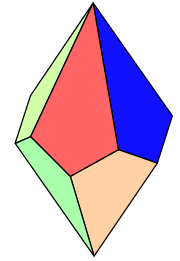 | |
| Type | trapezohedra |
| Coxeter diagram | |
| Faces | 10 kites |
| Edges | 20 |
| Vertices | 12 |
| Face configuration | V5.3.3.3 |
| Symmetry group | D5d, [2+,10], (2*5), order 20 |
| Rotation group | D5, [2,5]+, (225), order 10 |
| Dual polyhedron | pentagonal antiprism |
| Properties | convex, face-transitive |
The pentagonal trapezohedron or deltohedron is the third in an infinite series of face-transitive polyhedra which are dual polyhedra to the antiprisms. It has ten faces (i.e., it is a decahedron) which are congruent kites.
It can be decomposed into two pentagonal pyramids and a pentagonal antiprism in the middle. It can also be decomposed into two pentagonal pyramids and a Dodecahedron in the middle.
10-sided dice
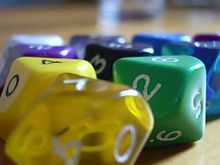
The pentagonal trapezohedron was patented for use as a gaming die in 1906.[1] It is convenient for role-playing games that use percentile-based skills; however, it is not strictly necessary since the outcome of a twenty-sided die can be divided ten ways and is sometimes preferred due to its regular shape. When a ten-sided die is rolled for a random digit, the outcome can be interpreted as 0-9 or (more commonly in role-playing) 1-10. Similarly two rolls provide 100 equally probable outcomes ranging 0-99 or 1-100.
Subsequent patents on ten-sided dice have made minor refinements to the basic design by rounding or truncating the edges. This enables the die to tumble so that the outcome is less predictable. One such refinement became notorious at the 1980 Gen Con[2] when the patent was incorrectly thought to cover ten-sided dice in general.
A fairly consistent arrangement of the faces on ten-digit dice has been observed. If one holds such a die between one's fingers at two of the vertices such that the even numbers are on top, and reads the numbers from left to right in a zigzag pattern, the sequence obtained is 0, 7, 4, 1, 6, 9, 2, 5, 8, 3, and back to 0. The even and odd digits are divided among the two opposing "caps" of the die, and each pair of opposite faces adds to nine.
See also
| 2 | 3 | 4 | 5 | 6 | 7 | 8 | 9 | 10 | 11 | 12 | ... |
|---|---|---|---|---|---|---|---|---|---|---|---|
| |
|
|
|
|
|
|
|
|
|
|
|
 |
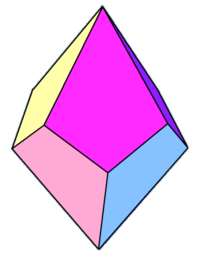 |
 |
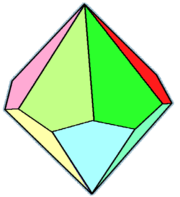 |
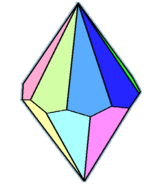 |
 |
||||||
| As spherical polyhedra | |||||||||||
 |
 |
 |
 |
 |
 |
 |
 |
||||
References
- ↑ U.S. Patent 809,293
- ↑ Greg Peterson about Gen Con 1980: The big news of the year was that someone had 'invented' the ten-sided die.
Sources
- Cundy H.M and Rollett, A.P. Mathematical models, 2nd Edn. Oxford University Press (1961), (3rd edition 1989) p. 117
External links
- Weisstein, Eric W., "Trapezohedron", MathWorld.
- Virtual Reality Polyhedra www.georgehart.com: The Encyclopedia of Polyhedra
- VRML model
- Conway Notation for Polyhedra Try: "dA5"
- Dungeons & Dragons Dice Roller
| ||||||||||||||||||||||||||||||||||||